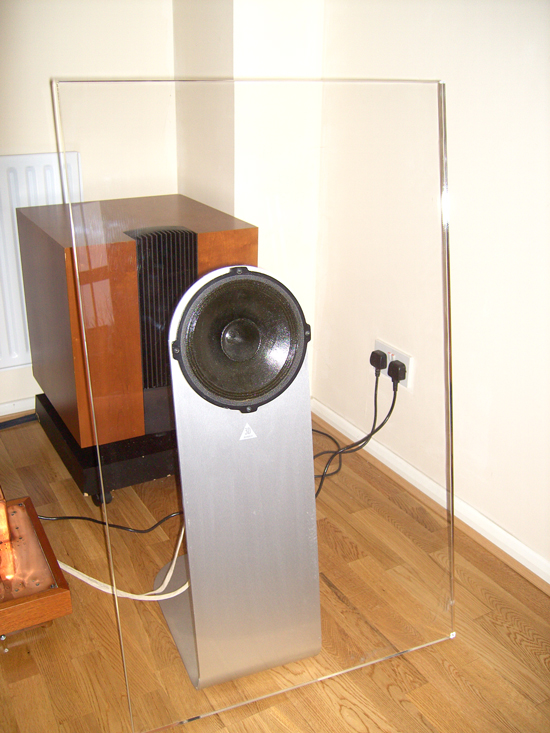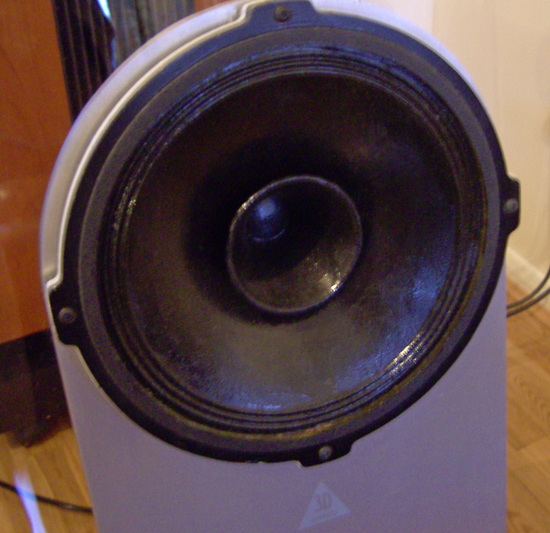The Test System
Before we go on to look at some of the PC software and hardware out there, I'll offer up a quick overview of the test system. Some of the components used really are out on a limb with price tags that are not for the faint of heart. In audiophile currency, I probably have what amounts to a mid-budget system. If your interest is in low budget products, be warned that the rest of this page will probably make your stomach churn. However, you've not been forgotten and we will add a few suggestions here and there should you have champagne tastes on beer budgets - as most of us probably do, especially in this time of credit crunch.
Speakers
 |
Real Hi-Fi owner and Supravox distributor Matthew Jameson was kind enough to provide us with a pair of test speakers based upon Supravox Signature Bicone Drivers known as the Transparence from a company called 3D Sonics. The Bicone Signature driver is a high efficiency (claimed 96dB sensitive) wide bandwidth design featuring a whizzer cone to supplement high frequency reproduction while the main cone takes care of the rest. The parameters of these drivers make them eminently suitable for an open baffle design like the Transparence.
If you keep your ear to the ground in loudspeaker circles, you'll know that open baffle loudspeakers have made a marked resurgence over the last five years or so. One of the chief perpetrators of this revival was a fellow named Throsten Loesch. Thorsten publicized his build of the Supravox Bicone Sig's using the very design that went on to become the 3D Sonics commercial venture. The remarkable simplicity was just what many in the DIY audio community were looking for: an easy to build high performance loudspeaker that could use a variety of drivers according to budget. I had the pleasure of listening to these speakers around five years ago at Thorsten's house; needless to say, it was an experience I never forgot. The absence of a walled cabinet allows the sound to fly out in all directions creating a soundstage that simply makes the loudspeaker drivers disappear.
All good things come with a slap around the cheeks and here's the part that the standard "boom 'n tizz" audio loving public won't like: the price tag is around £2400 UKP for a pair of these beauties. In audiophile markets, a price tag like this is hardly sweat inducing as there are plenty of high-end designs that cost multitudes more. If you are worried about the price, there's no reason to fret as DIY'ing a pair yourself that should get within 95% of the commercial model is not out of the question.
 3D Sonics makes an in-house change to the drivers that involves coating them with a few layers of C37 lacquer to humanize the sound. |
Stock signature Bicone drivers are available for DIY endeavors from Supravox USA, Supravox France for the EU, and direct from Real Hi-FI for the UK at around a third of the cost of the "ready to go" Transparence. If that's still too much for you, another door is open by using the budget friendly Visaton B200 driver with suitable baffle adjustments to suit its parameters.
The Transparence design is fiendishly simple: a single driver in a 6'x4' acrylic baffle that uses an aluminum L-bracket as a stand and as a means of providing additional rigidity to the baffle. There's no crossover as the driver covers the range of 50 Hz to 15 KHz on its own. That's most of the audible range covered by a single point source. While the top-end extension is enough even for super ears, the low-end obviously needs augmenting with a subwoofer for bass heavy music. For this purpose I use a Linn AV 5150 subwoofer crossed over at around 48 Hz that integrates very well with these speakers, especially when we use DRC to level some of the room response abnormalities.
Whether or not you have the financial clout to buy the fully fledged 3D Sonics Transparence, it's certainly worth investigating the sonic landscape that open baffle designs can create. The availability of drivers for just about every budget leaves the onus of their use squarely in the hands of the DIY'er. Don't pass up the chance to try them out.










114 Comments
View All Comments
mindless1 - Monday, December 1, 2008 - link
The fact is, even audio streams that measure the same can and do still sound different. The problem is the resolution of measurement and the misconceived notion that the brain interprets sound at a fixed interval as measured.There's a lot of snake oil in the audiophile world, but there's also a lot of what you'd like to call "magic" only be cause you don't accept it as non-magic.
Any decent DAC would in idealized theory be as good, but in practice a different IC topology may lend itself better to certain inherant localized noise frequencies and cutoffs, be better mated to the circuit it's dropped into, have drifts from thermal changes, etc. If they were all the same why would there be so many? I will agree that which modern DAC is used in a reasonably good design matters less than what follows after it in the chain but the best way to minimize any potential for degradation is to start out with what is most likely to minimize it in every way possible then following this concept the entire time, waiting and seeing if the end result is audibly different rather than downplaying them all without knowing the additive result yet.
CSMR - Monday, December 1, 2008 - link
Yes if you are maximizing quality you will choose the best of all components. But it's more sensible to care about cost and time too, so you have to prioritize. The value of the research about the unimportance of DACs (at at beyond a certain level) is that you can stop worrying about this part of the chain and spend you time/money where it is important.JonnyDough - Tuesday, December 2, 2008 - link
Exactly my point. Why spend more on one component if it's going to be "bottlenecked" by another one. Spending $2000 on a nice amp is crazy if your other components are crap. I think in the end it's like all other techs. You want decent stuff for a reasonable price unless you have more money than brains. While I scoff at people willing to spend more than few thousand on a sound system, without them we wouldn't have gotten to where we are today - with good possibilities on the market. As long as you like what you hear, who cares if it's perfect? At one point is something "good enough?" I mean honestly, there are people starving in the world, friends dying of cancer, etc...and we want to worry about whether or not something is inaudibly "perfect." Blow your money on something that MATTERS, you can't listen to music every hour of everyday unless your job is singing.CSMR - Tuesday, December 2, 2008 - link
I meant you can spend time/money on speakers/room acoustics/dsp but food for starving people is admittedly a better use of time and money.JonnyDough - Wednesday, December 3, 2008 - link
That's actually a matter of perspective. For example, you can donate food to a starving kid in some third world country and next thing you know that child has three kids and no way to feed them - and you've just marginally made the problem worse, not better.I think money is better spent on education, which leads to fewer babies. Many countries do not have quality farmland that can support the population on their own (the U.S. supports a large percentage of the world's population). Then there's natural habitat destruction, pollution from oil for having to ship food to them, etc. You get the picture.
JonnyDough - Monday, December 1, 2008 - link
While I was generally agreeing with CMSR above, I guess what everyone ends up saying is that hearing is subjective, which is something audiophiles are always agreeing upon yet they still love to argue over things.Does a vinyl record produce better sound than a CD?
It depends on what an individual values most.
A CD may produce less static noise, but have a "duller" sound, seemingly less highs and lows. It all depends on what one appreciates with their own ears.
While there are measurements that can be taken in a closed chamber, one sound system might actually sound better in a specific home or room than another for whatever reason. Even so, the average person can rarely tell a difference these days between the moderately priced components.
The really silly thing is that people will spend $200 on a sound card and then use cheap plastic speakers.
Rajinder Gill - Monday, December 1, 2008 - link
Lol, it's ok, everyone in entitled to have their say.It's the first piece so bear with us while we try to cater to a wider set of ideals.
With regards to the obj/subj stuff, it's an argument that'll never be solved.
later
CSMR - Monday, December 1, 2008 - link
Sorry if I came on too strongly; I was just expecting that Anandtech would have not necessarily an expert take but at least a more technical take than you get in audiophile communities.I would do some more fundamental thinking about what are the key factors in computer audio playback.
As a start you could rank in terms of what is most critical:
computer performance, computer quietness, software (drivers, dsp), analog line out, volume control, amplification, cables, speakers, room acoustics.
I won't give you my list but you should think about it and it is possible to compare many of these things in a very quantitative way, and some are more important than others by several orders of magnitude.
AnnihilatorX - Monday, December 1, 2008 - link
A dumb question about correction.The theory behind it is simple enough, but why do we need dedicated hardware to do the correction? Why can't we use simple graphical equalizers? I understand graphical equalizers are quite discrete in the range of selectable frequencies. How much difference does it make?
Rajinder Gill - Monday, December 1, 2008 - link
DRC - ease of use and range of control, plus taking care of things in the digital realm rather than in the analogue.You could fudge some control with a multi band digital equaliser and the means to measure the response, but it'd be damn tedious and utimately limited.